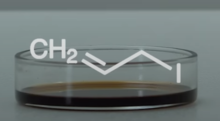
| |
| Names | |
|---|---|
| Preferred IUPAC name 3-Iodoprop-1-ene | |
| Other names
Allyl iodide 3-Iodopropene 3-Iodopropylene 3-Iodo-1-propene Iodoallylene 2-Propenyl iodide | |
| Identifiers | |
| CAS Number | |
| 3D model (JSmol) | |
| ChemSpider | |
| ECHA InfoCard | 100.008.302 |
| EC Number |
|
| PubChem CID | |
| UNII | |
| UN number | 1723 |
| CompTox Dashboard (EPA) | |
InChI
| |
SMILES
| |
| Properties | |
| Chemical formula | C3H5I |
| Molar mass | 167.977 g·mol |
| Appearance | Pale yellow liquid |
| Density | 1.837 g/cm |
| Melting point | −99 °C (−146 °F; 174 K) |
| Boiling point | 101 to 103 °C (214 to 217 °F; 374 to 376 K) |
| Hazards | |
| GHS labelling: | |
| Pictograms |  
|
| Signal word | Danger |
| Hazard statements | H225, H314 |
| Precautionary statements | P210, P233, P240, P241, P242, P243, P260, P264, P280, P301+P330+P331, P303+P361+P353, P304+P340, P305+P351+P338, P310, P321, P363, P370+P378, P403+P235, P405, P501 |
| Flash point | 18 °C (64 °F; 291 K) |
| Safety data sheet (SDS) | MSDS at Sigma Aldrich |
| Except where otherwise noted, data are given for materials in their standard state (at 25 °C , 100 kPa). Infobox references | |
Allyl iodide (3-iodopropene) is an organic halide used in synthesis of other organic compounds such as N-alkyl-2-pyrrolidones, sorbic acid esters, 5,5-disubstituted barbituric acids, and organometallic catalysts. Allyl iodide can be synthesized from allyl alcohol and methyl iodide on triphenyl phosphite, Finkelstein reaction on allyl halides, or by the action of elemental phosphorus and iodine on glycerol. Allyl iodide dissolved in hexane can be stored for up to three months in a dark freezer at −5 °C (23 °F) before decomposition into free iodine becomes apparent.
See also
References
- ^ Bertleff, Werner (2000). "Carbonylation". Ullmann's Encyclopedia of Industrial Chemistry. pp. 9, 14–15. doi:10.1002/14356007.a05_217. ISBN 978-3527306732.
When unsaturated amines are carbonylated in the presence of Co2(CO)8, N-alkyl pyrrolidinones are obtained. Carbonylation of allyl halides in the presence of primary amines and a rhodium compound affords the same products....If allyl derivatives are carbonylated in the presence of acetylene by means of Ni(CO)4 and water or methanol at 20 °C, the acetylene adds onto the allyl halide and 2-cis-5-dienoic acids or esters or sorbic acid esters are obtained.
- Wollweber, Hartmund (2000). "Hypnotics". Ullmann's Encyclopedia of Industrial Chemistry. p. 521. doi:10.1002/14356007.a13_533. ISBN 978-3527306732.
Disubstitution of barbituric acids at the 5-position is only possible with highly reactive halides, such as allyl halides.
- Behr, Arno (2000). "Organometallic Compounds and Homogeneous Catalysis". Ullmann's Encyclopedia of Industrial Chemistry. p. 10. doi:10.1002/14356007.a18_215. ISBN 978-3527306732.
Halogen-containing allyl complexes can often be prepared simply from reactions of allyl halides with metal compounds.
- Patnaik, Pradyot (2007). A Comprehensive Guide to the Hazardous Properties of Chemical Substances 3rd Ed. New Jersey: John Wiley & Sons. pp. 141–142. ISBN 9780471714583.
- Adams, Rodger (1944). Organic Reactions, Volume II. New York: John Wiley & Sons, Inc. p. 22.
- Schorlemmer, C. (1874). A manual of the chemistry of the carbon compounds. London: Macmillan and Co. p. 262.
- Datta, Rasek Lal (March 1914). "The Preparation of Allyl Iodide". Journal of the American Chemical Society. 36 (5): 1005–1007. doi:10.1021/ja02182a023. Retrieved 15 December 2013.
- Armarego, Wilfred; Chai. Christina (2012). Purification of Laboratory Chemicals. Kidlington: Elsevier. p. 114. ISBN 9780123821614.
This article about an organic halide is a stub. You can help Misplaced Pages by expanding it. |